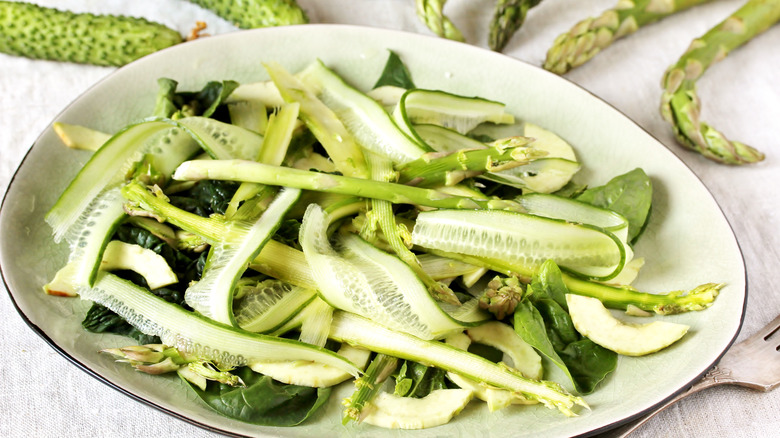Why A Mandoline Is Key To Elevating Your Salad Making Game
We may receive a commission on purchases made from links.
There can be a big gap between salads you can order at a restaurant and salads you make at home. While you're out to eat, there is a plethora of options with everything from microgreens to roasted beets. Homemade salads, however, are often nothing more than a salad mix from the bag and maybe a few chopped-up cucumbers and tomatoes.
Salads at home don't have to be boring though, and unless a restaurant salad was assembled with kitchen tweezers, as they do at high-end restaurants, you can probably make something similar at home. And for the most part, salads don't require any cooking (or at least not very much).
One of the keys to restaurant-quality salads is to get imaginative and use unconventional fruits and vegetables that you don't normally associate with salads. Take some inspiration from what's in season, like Brussels sprouts, asparagus, radishes, snap peas, carrots, parsnips, winter squash, and fennel.
The other trick that chefs use for making cool salads, especially when using hard, chunky vegetables like carrots and radishes, is to slice them super thin. If you want to jazz up your salad life, invest in a mandoline on your next trip to the kitchen store.
The case for mandolines
Mandolines often rank pretty high on a chef's list of kitchen tools, including Andy Baraghani who said in his cookbook "The Cook You Want To Be," that his Benriner model "isn't just more efficient than a knife; it does things no knife can do," (per Bon Appétit). If you've never heard of a mandoline, it's a specialized slicing tool that can make super thin, uniform cuts by sliding food against a blade mounted on a flat panel. Chefs use commercial-sized versions to make all kinds of components for your dinner plates, like potato gaufrettes (the fancy name for waffle fries), and they come in a lot of different sizes and shapes (per Food Network).
You probably won't be using your mandoline at home to prep veggies daily, so you don't need to spring for anything big and fancy — instead, you can get a small model mandoline for your home kitchen for around $20. That said, you can get a lot of mileage out of a mandoline. They're the tool of choice for making perfect slices of spuds for classic scalloped potatoes, eggplant for parmesan, julienned summer squash and zucchini, which you can substitute in any recipe for zoodles, and for shredding potatoes for hash browns or potato pancakes.
Shaved vegetables for salads
If you set your mandoline to extra thin, you can make some pretty classy salads that will rival anything you can get at a fine dining restaurant. With just a few swipes across the blade you can, as Jamie Oliver says, "turn something frumpy into something gorgeous." A boring beet suddenly becomes a sexy, translucent slice, which is not only lovely to look at, but also has way more surface area for distributing dressing (per America's Test Kitchen). Plus the acid in a vinaigrette softens the vegetable's texture, and thin slices are easier for picking up with a fork than clunky chunks.
A shaved vegetable salad also seems much more put together than a pile of greens, even though it doesn't take any more time to prep your dish with a sharp mandoline than it does to make a chopped salad. If you don't have a mandoline, however, you can also use a regular vegetable peeler, which is how chef Johnathan Waxman does it at Barbuto in New York City (per the Los Angeles Times).
Just be sure when you're using a mandoline to always use the safety guard, or invest in a cut-resistant glove as it's very easy to cut yourself when you get down to the end of the bit of vegetable you're shaving. Also, make sure your mandoline's blades are always super sharp so that everything slices evenly, and so you don't have to work too hard to push things across the edge.

